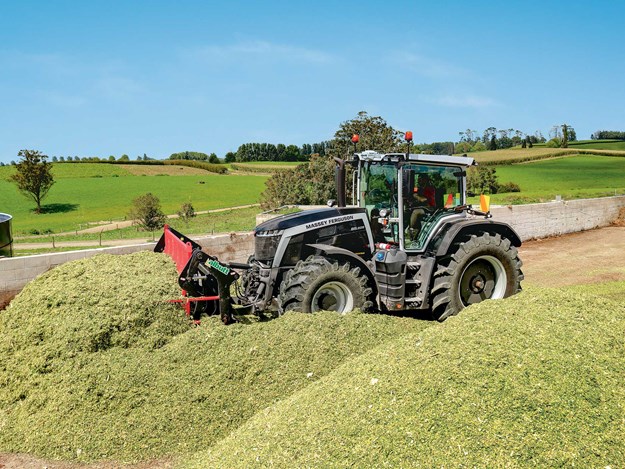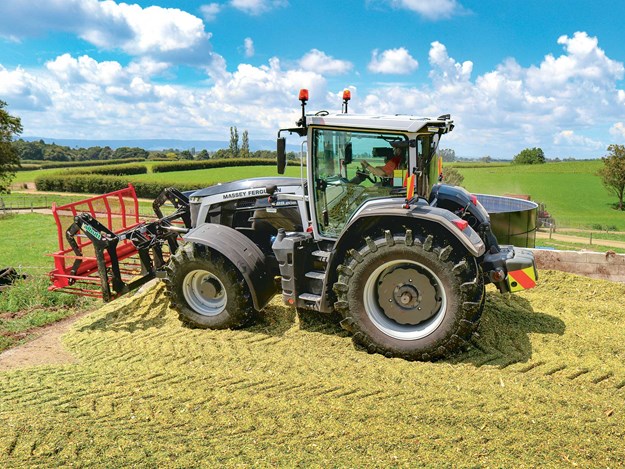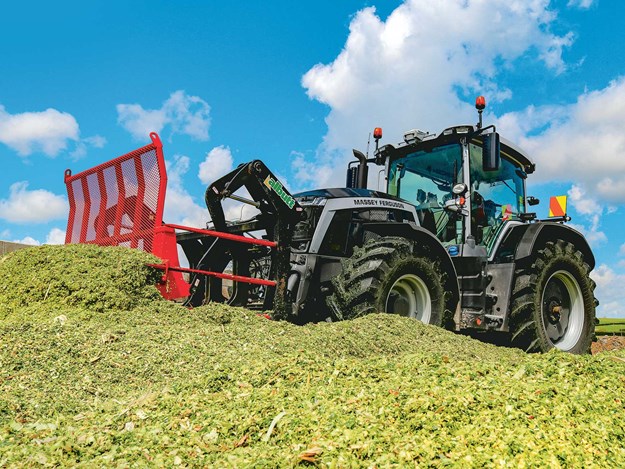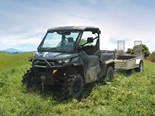Test: Massey Ferguson 8S
The arrival of the new Massey Ferguson 8S onto NZ shores has been highly anticipated, and we find out whether the fanfare is deserved

The arrival of the new Massey Ferguson 8S onto New Zealand shores has been highly anticipated. Having been available in the UK and Europe since mid-2020, where farmers and contractors have been putting this completely new design to work, we’ve had to wait a while longer.
The first leaked online photos of the Massey Ferguson 8S date back to the early 2010s, which demonstrates the years of development that has gone into this machine. The 8S represents a new era for Massey Ferguson, revamping its tractor model badging along with its styling (including the introduction of the grey sabre stripe throughout most of the
range, along with a grey cab). This style pays tribute to the Massey Ferguson heritage, spanning back to the MF 100 and 3000 series.
The versatile long-wheelbase 7700 Series is replaced by the 8S Series, which brings with it a horsepower rating from 205 to 305hp. Being a popular size bracket for contractors in New Zealand, it won’t take long to spot these Massey Ferguson 8S machines as they spread around the country.
 |
|
A powerful performer with a solid base for tackling heavier jobs
|
Having run an MF 7624 Dyna-VT for several years, Waikato contract Kyle Selman indent ordered his new MF 8S as soon as they were released, as a replacement for his trusty 7624.
Having always wanted a black tractor, for as long as he can remember, he ran with the opportunity to get the MF 8S in black. The result is stunning. Finally arriving this year, Kyle is stoked with his new tractor, and we jumped at the opportunity to see the machine first-hand and experience the new tech the ‘Tractor of the Year 2021’ has to offer.
Specs
Beneath the fresh new bonnet, the proven and torquey six-cylinder, 7.4-litre AGCO power engine resides. It joins the rest of the market in Stage V emissions regulations.
Available in 8S.205, 8S.225, 8S.245, 8S.265, 8S.285, and 8S.305 models, producing 205, 225, 245, 265, 285, and 305 rated horsepower respectively. All models except the 305 boost 20hp in certain work conditions.
Service intervals for the engine sit at the 600-hour mark. Available with three different transmission options, there is a set-up to suit everyone’s requirements. Dyna-7 is based on the current Dyna-6 transmission but with an extra powershift gear.
-2.jpg) |
|
The slim wasp bonnet design allows great visibility
|
Dyna-E is a dual-clutch transmission, and the Dyna-VT is a variable transmission that a lot of operators will be familiar with. The rear end of the 8S Dyna-VT is similar to the larger 8700 series, which covers up to 400hp. The 8S ends up being a touch longer than the previous LWB (long wheelbase) 7700 series, resulting in a 3.05-metre wheelbase.
In terms of manoeuvrability, an impressive 5.7-metre turning circle can also be achieved, which is impressive for this size tractor. Hydraulic capacity has been increased significantly, now offering a 205 litres per minute pump as standard with the Dyna-VT transmission.
The overall weight of the 8S comes in at 12 tonnes, making it suitable for those heavier tasks and heling when it comes to lugging machinery around hills. A 500-litre diesel tank is saddled underneath the cab in conjunction with a 43-litre AdBlue tank. This remarkable tank capacity allows for a long day’s work, minimising the need for refuelling. The 8S has leapt out of the ordinary in terms of tractor and cab design, which takes a touch to get used to at first. The fishbowl-like cab is situated a substantial 24cm from the engine. This reduces in-cab noise drastically and allows the operator a more comfortable environment. It also allows the newly designed air intake to suck in air from the rear of the engine, in front of the cab, which designers say improves cooling capabilities and efficiency.
 |
|
The front axle has great range of travel for stacking applications
|
With the rear end replaced with a more heavy-duty drive train, the engine that saw the last 7700 Series out has had some extra meat added. A chassis rail supports the engine’s subframe and adds strength to help carry heavier implements that this larger tractor will likely be undertaking.
Front linkage capacity has been increased to 4800kg and coupled with multiple other upgrades, gives the 8S a great frame and driveline. The Vario transmission gives extremely smooth shuttling and constant drive from zero to 53kph.
Test time
A definite presence of staunchness is felt when near the MF 8S. Such a radically new can design takes a little getting used to and, like anything new and innovative, attracts mixed opinions.
Immediately noticeable is the amount of visibility out of the tractor cab. The wasp-like body design allows a great view of the front axle and front linkage. With no diesel or hydraulic tanks limiting visibility out the side or front, there’s an extra sense of awareness about your surroundings.
 |
|
Superb view range out of the front windscreen
|
Kyle spec’d this tractor with a pick-up hitch from the factory. Having buttons on the locking handle to operate the hitch is a great feature and saves moving and looking around the cab for the spool that controls it.
This new cab delivers many positives for operator comfort. The space is great, with almost all controls now residing on the armrest, except hydraulic and linkage locking buttons which, when the lock light is lit up, shows they are unlocked.
Operation control
Both armrest joysticks have had changes made. The main one now has a speed scroller (formerly would have been a C2 scroller on the right control panel), along with a high/low button to change transmission mode.
Linkage controls have gone back to a rocker switch on the handpiece, which is nice to use. The quick drop feature is still present by holding the downside of the switch, which is a positive note.
The forward-reverse shuttle on the controller was a little bit of a let-down, as to be able to use the shuttle on the right-hand side, the left-hand shuttle lever needs to be taken out of park, put into forwards or reverse, and moved back to neutral. Then, combined with the clutch pedal depressed, the button on the back of the right handpiece, along with the forward or reverse button pressed, will select the direction. This leaves the operator unable to alternate which hand changes the direction of the tractor, as the left-hand shuttle lever will override the right-hand side selection. It’s something that just takes a bit of getting used to before becoming second nature. Many improvements have been made to the layout to make the operator’s day easier. A positive touch that wasn’t present on older models is that the hand throttle no longer makes the transmission drive. This makes checking and starting implements much more user-friendly, as the revs can be set while staying stationary. The addition of radio, air con, along with phone and light controls to the armrest has improved the ergonomics of the tractor greatly. Operators don’t need to reach as far to adjust these simple background elements.
The move from a vertical position of the linkage dial to a horizontal position allows operators to visualise and control the rear linkage better.
-2.jpg) |
|
Hydraulic capacity is an impressive 205 l/pm
|
Our test day in Matamata was yet another wet one courtesy of Summer 2023. On the plus side, it gave me the chance to test out the window wipers. This has to be one of the best on the market with the amount of area getting cleaned. The vertical blade mounted on a parallelogram linkage covers pretty much the entire windscreen.
Kyle also had his tractor spec’d with side window wipers for those days drilling where the dust sticks to the drops from light showers. Smart move.
A fridge under the passenger seat keeps drinks and lunch cool. While the new steering wheel is stylish, for me, the rather bulky spokes can be uncomfortable to hold at first. The indicator stalk is quite high and difficult to knock naturally until you get used to where it suits. Also being non-self-cancelling seems out of place in such a modern machine.
The positioning of the key and light switch was rather peculiar, too. Placed
in the centre underneath the steering column, it was prone to a knee-knocking when turning to look at the implement behind the tractor.
The addition of the monitor rail streamlines cab layouts and provides a strong sturdy rail for screens to be mounted via a ram mount. Plenty of three-pin D plugs along with multiple USB ports ensure all systems won’t be without power. Overall, the 8S is extremely comfortable to sit in and doesn’t take long to settle in to operate the machine smoothly.
Tech
Control screens on modern tractors have turned into the heart of the machine, and without knowing how to set the tractor up correctly through the screen, even the simplest tasks can prove difficult.
The 8S has Massey Ferguson’s Datatronic 5 installed, which is a step ahead of previous models. A new system is always hard to get your head around, and Kyle and I spent a good 15 minutes going through every folder, discovered some neat features, and got familiar with navigating the menus.
The ability to quickly change between different profile set-ups is impressive.
The imports saved the operator’s settings onto the tractor, making the machine easy to use. Another aspect I like is the standard mode, where any different operator can select and adjust their settings without ruining the main operator’s saved settings.
 |
|
A 3.05m wheelbase is a good size for the power and compactness
|
Implement and work counters are easy to set up, providing a decent amount of efficiency information. Another aspect I found impressive is the ability to set the angle that the four-wheel-drive would disengage. This small detail allows an operator to set the machine up to better suit the task at hand.
The 8S also introduces the ability to change between stick and pedal modes on the go, without pressing any buttons. This again simplifies life and improves efficiency. The only downside is that when on the road, pulling back on the stick to transmission brake puts the tractor into stick mode, and it will carry on at that speed instead of rolling to a stop. After a few days of driving, you soon get used to how it reacts though.
Summary
The Massey Ferguson 8S has had much careful thought put into it, designed to strongly navigate the 200 to 300hp market. With a strong reliable engine, beefed-up chassis, and weighty dyna-VT rear end, the base of this tractor has a solidly built platform to tackle heavier jobs.
The huge hydraulic capacity provides the push power for demanding applications. The spaceship-like cab takes a bit to get used to from the outside, but visibility and quietness from the inside confirm that the design changes were worth the effort. Smooth and torquey power delivery complements the operation. Apart from the few functionality niggles for me (as with any new tractor design), it’s an extremely comfortable tractor with a high amount of tech to please the most experienced operators.
 |
|
The MF 8S new styling is eyecatching from all angles
|
A growing business
Kyle started by buying and rebuilding a Duncan Enviro 3000e drill. A Massey Ferguson 7624 was purchased to provide the pulling power for the drill. While working for an existing contractor, he did drilling on the side, which soon picked up to the point where being
self-employed was the better option. Having Klaus AG based nearby, Kyle spent a fair amount of time helping them out, driving or subbing in. Their range of machinery complements each other and a wide range of services are offered.
Adding machines every season, such as power harrows, rippers, maize planters, and buck rakes, Kyle has diversified his operation to accommodate a variety of farmers’ needs.
With drilling expanding more, a Väderstad Rapid 400a drill was bought to replace the Duncan. Having put it through the workshop and modifying it to have three product application bins, an array of products can be applied further accommodating local farmers’ needs.
After a few weeks operating the MF 8S, Kyle states that it’s been "bloody comfy" and the "7.4-litre AGCO power engine has some great power."
Massey Ferguson 8S.205 specificatons
| Engine | 7.4L AGCO power (sisu) |
| Horsepower | 205hp (225hp boosted) |
| Torque | 950Nm (1000Nm on boost) |
| Service intervals | 600 hours |
| Rear linkage capacity | 10,000kg |
| Front linkage capacity | 4800kg |
| Lights | 16 LED |
| Wheelbase | 3.05m |
| Fuel capacity | 500L |
| AdBlue capacity | 43L |
Pros
- Large spacious cab
- Front windscreen wiper
- Clear cab layout and visibility
- Great reliable engine
- Strong drivetrain (Dyna-VT)
- 205L/min hydraulic pump
- Full LED lights
Cons
- Cannot change direction on left and right side in the same sequence
- Indicator stalk not self-cancelling
Find new and used farm machinery for sale in NZ
Keep up to date in the industry by signing up to Farm Trader's free newsletter or liking us on Facebook











.jpg)


.png)

